Starting on the enchanting journey of fluid art is like releasing a vibrant river of creativity, and having the right tools is vital! Every fluid artist needs high-quality acrylic paints, like those from Liquitex Basics or Amsterdam, for luscious, flowing colors. Pouring mediums, such as Liquitex or Golden GAC 800, are key to achieving that perfect consistency. Silicone cups, mixing sticks, and accurate measuring tools guarantee precision and ease during preparation. Don’t forget, prepping a sturdy, triple-primed canvas and wearing protective gear like gloves and aprons is fundamental. Beyond these basics, there’s so much more to enhance your fluid art experience.
Key Takeaways
- Acrylic Paints: Select high-quality brands like Liquitex Basics, Winsor & Newton Galleria, or Amsterdam for vibrant, consistent results.
- Pouring Mediums: Use Liquitex Pouring Medium or Golden GAC 800 to control paint flow and prevent cracking.
- Mixing Supplies: Use silicone mixing sticks, silicone cups, and measuring jugs for precise and contamination-free mixing.
- Surface Preparation: Prime canvases and wood panels with gesso to ensure paint adhesion and color vibrancy.
Acrylic Paint Choices
When selecting acrylic paints for fluid art, it is essential to take into account both the brand and type of paint to achieve the desired effects and quality in your work. The choice of paint brands can greatly influence the final outcome of your artwork, with options like StudioAcrylics (Pebeo), Amsterdam, Winsor & Newton Galleria, and Liquitex Basics being highly recommended for their diverse color ranges and excellent quality suitable for pouring techniques.
Exploring the Pebeo Iridescent Line can add a stunning visual effect to your pieces, thanks to its shimmering dry colors. For those who enjoy experimenting, using regular acrylic paint mixed with a pouring medium, rather than premixed pouring paints, allows for greater versatility and a wider range of techniques.
Understanding color theory is vital when selecting and mixing paints. Basic colors like black and white are indispensable for creating contrast and dynamic effects. Utilizing the color wheel can enhance your ability to create harmonious or striking color combinations.
Quality paints such as Golden fluid paints are known for their superior mixing properties, ensuring best results in fluid painting projects.
Pouring Mediums
When it comes to pouring mediums, artists have a variety of options that can greatly change the outcome of their work.
From commercial products like Liquitex Pouring Medium and Golden GAC 800, which offer excellent clarity and prevent cracking, to more budget-friendly alternatives like Floetrol and PVA glue, the choice of medium can make a huge difference.
Understanding these options allows artists to tailor their techniques and achieve their desired effects with greater precision.
Types of Mediums
Pouring mediums play an essential role in fluid art, determining the flow, consistency, and final appearance of the artwork. Different pouring techniques and medium combinations can greatly affect your results, making the choice of medium vital.
Commercial pouring mediums are specifically designed for acrylic pouring, providing the perfect consistency for smooth application and vibrant finishes. They help maintain the paint’s integrity, ensuring it flows well without breaking apart.
For those looking to experiment, Floetrol and PVA Glue are popular alternatives that can be more budget-friendly. However, they can produce varying effects, so it’s important to test them out to see if they meet your creative needs.
When mixing your paint, adding water can reduce viscosity, but be cautious not to overdo it. Too much water might weaken the paint’s binding properties, leading to cracks or a dull finish.
To achieve the best results, mix acrylic paint with your chosen pouring medium. This combination allows for greater versatility in techniques, giving you the freedom to create stunning, unique pieces.
Alternative Medium Options
Exploring alternative medium options, such as Floetrol and PVA Glue, can provide fluid artists with cost-effective solutions while still achieving diverse and enchanting effects in their work. These alternative mediums can be a real game-changer, especially if you’re looking to save some bucks without compromising on the quality of your art.
Floetrol, often used as a paint conditioner, offers a smooth flow and can help create those coveted cell effects. PVA Glue, on the other hand, is a versatile option that can be mixed with water to thin out acrylic paints. However, be cautious—too much water can mess with the paint’s binding properties, potentially ruining your masterpiece.
Choosing the right pouring medium can make a huge difference in your artwork. While commercial pouring mediums are specially formulated for best results, experimenting with alternatives like Floetrol and PVA Glue can lead to unique textures and finishes.
Just remember, mixing ratios are key! Always follow the guidelines provided by the medium and paint manufacturers to avoid any unexpected surprises. So, if you’re up for a bit of experimentation and want to explore cost-effective options, these alternative mediums might just be what you need to enhance your fluid art to the next level!
Mixing Supplies
When it comes to mixing supplies, getting the right tools is essential for achieving perfect paint consistency.
You’ll need silicone or reusable wooden mixing sticks, silicone cups with spouts for easy pouring, and measuring jugs to guarantee accurate ratios between your paint and pouring medium.
Don’t forget to clean your tools after each use to maintain their quality and have tweezers on hand to remove any unwanted residue.
Essential Mixing Tools
For fluid artists, having the right essential mixing tools is essential for achieving consistency and quality in their work. The proper tools guarantee that mixing techniques are executed efficiently, leading to beautiful and consistent results. One of the key items is measuring jugs, which help in precise quantities of pouring medium and paint. Accurate measurements are important for maintaining consistency.
Mixing sticks, whether silicone or reusable plastic, play a significant role in combining paints and pouring mediums without contamination. These sticks can be cleaned and reused, which is an important aspect of tool maintenance. Silicone cups with spouts are another must-have, allowing for easy mixing and pouring while reducing waste since they can be reused.
Having a variety of vessels, such as paper cups or jars, is also beneficial for mixing different colors and staying organized. Regularly cleaning these mixing tools after each use is necessary to maintain paint quality and prevent clogs or gunk buildup.
Here’s a quick reference table to visualize these essentials:
| Mixing Tool | Purpose | Benefits |
|---|---|---|
| Measuring Jugs | Precise measurement of materials | Consistency and accuracy |
| Mixing Sticks | Combine paints and mediums | Reusable, prevents contamination |
| Silicone Cups | Easy mixing and pouring | Reusable, reduces waste |
| Paper Cups/Jars | Mixing various colors | Organization and convenience |
Accurate Measuring Techniques
Accurate measuring techniques are vital in fluid art to guarantee the precise ratios of pouring medium to paint, which directly impact the quality and consistency of the final artwork. Imagine spending hours on a piece only to see it ruined by incorrect proportions—nightmare, right? That’s why measuring accuracy is your best friend.
First off, grab some accurate measuring jugs. These little helpers make certain your paint and pouring medium mix together in perfect harmony, giving your art that professional touch. When working with larger quantities, graduated measuring tools become lifesavers, helping you maintain those essential proportions.
Now, let’s talk digital scales. These gadgets provide precise measurements by weight, which is essential for nailing specific techniques. A little too much or too little can throw everything off, so trust the scales—they know their stuff!
Don’t forget mixing sticks—they need some love too. Clean them after each use to avoid color contamination and keep your mixtures pure.
And hey, why not bring a color wheel into the mix? It helps balance and harmonize your colors, making your artwork pop.
Surfaces for Pouring
Selecting the appropriate surface is vital for achieving ideal results in fluid art, as it directly impacts the texture, color vibrancy, and overall quality of the finished piece.
When considering canvas types, it’s important to choose sturdy, triple-primed canvases to prevent sagging. This means the canvas has been coated three times with a primer, which helps the paint adhere better and keeps it from soaking through. If you have old canvases lying around in good condition, don’t toss them out—they can be reused, giving them a new life with your next masterpiece.
Surface preparation is another important step. If you prefer working on cradled wood panels because they’re flat and great for resin applications, be certain to seal and prime them with gesso. This not only protects the wood but also guarantees that your paint sticks properly, preventing any disappointment later on.
Additionally, using acrylic pouring pads or even incontinence bed sheets can be a clever trick to absorb excess paint and protect your workspace. These surfaces might not be the stars of the show, but they play a key supporting role, keeping everything neat and tidy while you focus on your art.
Essential Tools
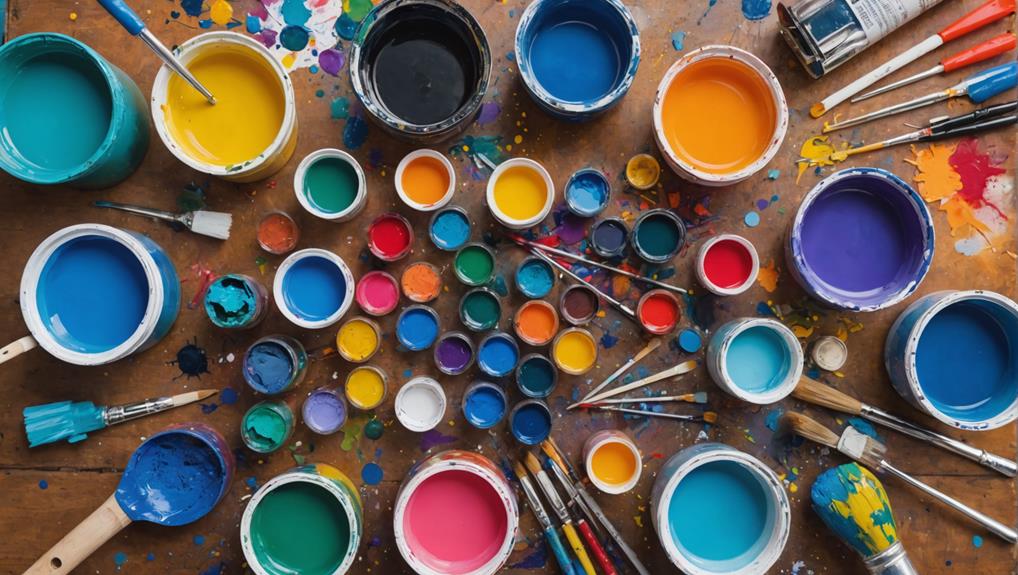
Fluid artists rely on an array of essential tools to create stunning, dynamic pieces that showcase their unique artistic visions. These tools are vital for achieving the right paint consistency and mastering color theory, guaranteeing each piece is vibrant and balanced. High-quality acrylic paints from reputable brands like Amsterdam and Winsor & Newton are fundamental, as the quality of paint directly impacts the final artwork.
To blend paint with pouring mediums and achieve the desired viscosities, a variety of mixing supplies are indispensable. Silicone or reusable plastic cups, mixing sticks, and measuring jugs are essential for this process. Additionally, tools like a torch or heat gun are necessary for popping air bubbles in poured paint, enhancing the final appearance of the artwork.
Squeeze bottles for storing pre-mixed colors are also recommended, allowing for easy application and reducing waste.
Here’s a quick rundown of some essential tools every fluid artist needs:
- High-quality acrylic paints (e.g., Amsterdam, Winsor & Newton)
- Mixing supplies (silicone cups, mixing sticks, measuring jugs)
- Torch or heat gun
- Squeeze bottles for pre-mixed colors
With these tools, fluid artists can guarantee their work is both technically sound and visually engaging.
Personal Protective Equipment
Guaranteeing proper personal protective equipment (PPE) is essential for fluid artists to maintain safety and comfort while working.
Safety practices start with wearing nitrile gloves, which protect your skin from paint and chemicals. These gloves are resistant to solvents and still let you move your fingers easily, so you can work without feeling restricted.
A well-ventilated workspace is vital to keep you safe from fumes that come from paints and pouring mediums. Breathing in these fumes can be harmful, so good airflow helps keep your environment comfortable and safe.
Wearing aprons or old clothes can save your favorite outfits from getting ruined with paint splatters. Once acrylic paint dries, it’s quite stubborn and hard to remove, so it’s better to be safe than sorry!
Safety goggles are another piece of protective gear you shouldn’t skip, especially when using blowtorches or heat guns. They guard your eyes against accidental splashes or flying debris.
Lastly, keep a fire extinguisher nearby if you’re working with heat sources. This simple safety practice guarantees you can quickly deal with any accidental fires, helping you stay safe while you create stunning fluid art.
Texturing Techniques
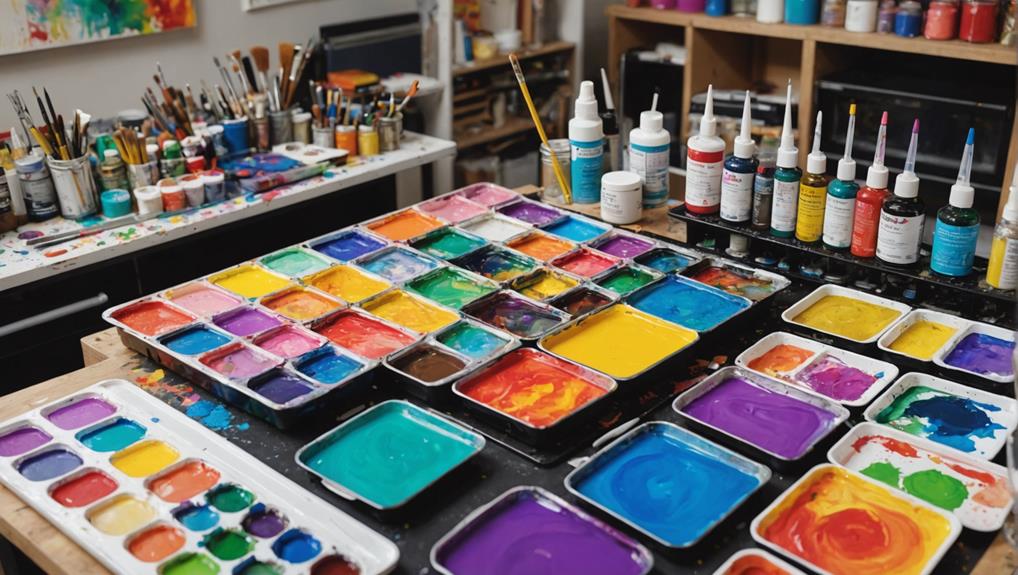
Exploring various texturing techniques can greatly improve the depth and visual interest of fluid art creations. By incorporating textured designs and layering techniques, fluid artists can raise their work to new levels of sophistication and complexity. Here are some effective methods to take into account:
- Gloss Gel: This versatile medium can be used to add intricate textured designs such as Mandalas and geometric shapes. Its thick consistency provides depth and dimension to any piece.
- Liquid Latex: Ideal for creating a 3D effect, liquid latex allows artists to mask certain areas during the painting process. This results in intricate detailing and advanced layering techniques.
- Stencils: Using stencils can help achieve precise embellishments and patterns, adding a professional touch to fluid art. They are perfect for enhancing the overall visual appeal of the artwork.
- Varnish: Available in spray or brush-on forms, varnish can protect textured surfaces while adding a finishing touch with options like Matte, Satin, or Glossy finishes.
Finishing Options
When it comes to finishing your fluid art masterpiece, you have a couple of great options.
Varnish, available in spray or brush-on forms with finishes like Matte, Satin, and Glossy, is perfect for beginners due to its ease of application.
For those looking for a more advanced technique, epoxy resin offers a stunning, thick, glossy finish, though it requires careful mixing and application to avoid bubbles and achieve a flawless surface.
Varnish and Spray Finishes
Various varnish finishes, including Matte, Satin, and Glossy, offer fluid artists the flexibility to achieve their desired aesthetic for each piece. The right finish can make all the difference in showcasing your artwork’s colors and textures.
Varnish application is a key step in protecting your art from dust, UV damage, and yellowing. When it comes to applying varnish, you have options: spray techniques or brush-on methods.
Spray varnishes are fantastic for larger pieces because they provide a quick, even coat. These sprays guarantee a smooth surface without brush strokes, making them ideal for achieving that flawless finish.
On the other hand, brush-on varnishes give you more control, allowing you to carefully cover detailed areas without missing a spot.
Here’s a quick rundown of the varnish and spray finishes you might consider:
- Matte Finish: Provides a flat, non-reflective surface that reduces glare and shines.
- Satin Finish: Offers a balanced shine that is not too glossy nor too dull.
- Glossy Finish: Enhances the vibrancy of colors, giving a shiny, polished look.
- Spray Varnish: Great for even, quick applications over large areas.
Always remember to follow the manufacturer’s instructions for drying times and application methods to obtain the best results.
Epoxy Resin Techniques
As an alternative to traditional varnishes, epoxy resin offers fluid artists a robust option for achieving a high-gloss, glass-like finish that greatly enhances the depth and vibrancy of their work.
When it comes to resin application, getting the mix right is essential. You need to mix the resin and hardener in precise ratios, usually 1:1, to make sure the curing process goes smoothly and your artwork looks its best.
Imagine working in a well-ventilated space, with gloves and masks on, ready to transform your creation. Pouring the resin mix evenly is key, and a heat gun or torch can be your best friend to get rid of those pesky air bubbles before the resin starts to cure. Just picture yourself using that torch, watching the bubbles pop, and seeing your artwork come to life with a shiny, glass-like finish.
For those new to this, don’t worry! There are plenty of online courses and tutorials designed to help you master epoxy resin techniques. They’ll guide you through the steps, from mixing to curing, and help you avoid common pitfalls.
Creative Exploration
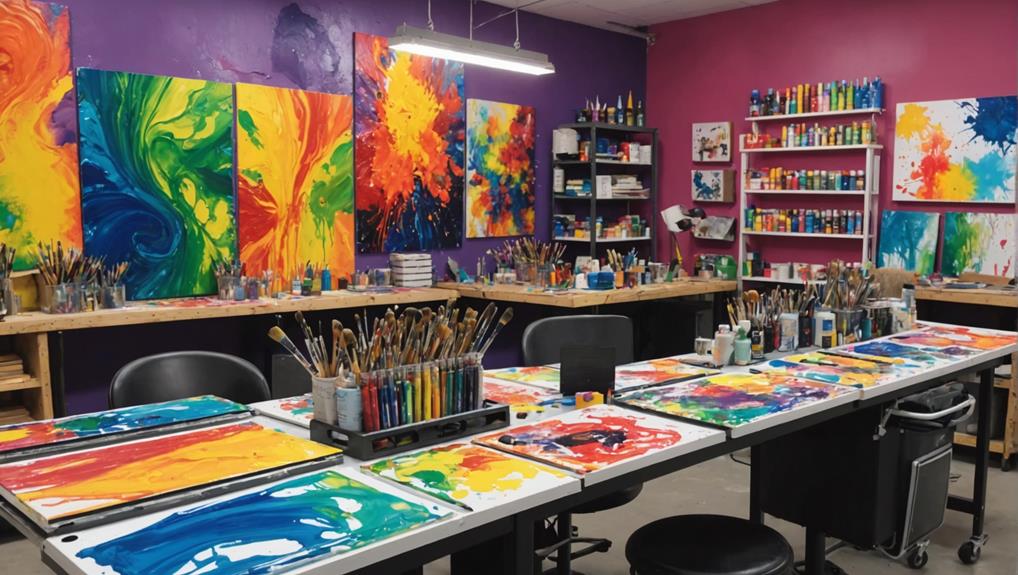
Exploring the diverse array of acrylic pouring techniques, such as flip cups and dirty pours, enables fluid artists to experiment with color combinations and layering, leading to one-of-a-kind artistic outcomes. This process of color exploration and artistic experimentation is essential for developing a unique style and pushing the boundaries of creativity.
By trying out different mediums and tools, like silicone or stencils, artists can discover new ways to manipulate paint and achieve stunning effects. Engaging in regular practice and experimentation helps artists refine their techniques and uncover their personal artistic voice.
Utilizing online courses and video tutorials can provide valuable insights into new methods, while also inspiring fresh ideas. Additionally, joining a community of fluid artists allows for the sharing of experiences, tips, and feedback, fostering collaborative projects and innovative approaches.
To further aid in creative exploration, keeping a journal or sketchbook to document techniques and ideas is highly beneficial. This practice not only tracks progress but also serves as a source of inspiration for future projects.
- Experiment with flip cups and dirty pours
- Incorporate mediums like silicone and stencils
- Take online courses and watch video tutorials
- Join fluid artist communities for shared learning
Canvas Preparation
Proper canvas preparation is a critical step in guaranteeing successful acrylic pouring results. Whether you’re using traditional or repurposed canvas types, the quality of your canvas directly impacts your artwork’s durability and appeal. Always opt for triple primed canvases, as this minimizes paint absorption and enhances longevity. Push pins are your best friend here—using them to support the canvas keeps it level, preventing warping and guaranteeing an even paint flow.
Frog tape works wonders for edge protection, keeping those borders crisp and clean. If you’re thinking about repurposing an old canvas, inspect it thoroughly. Check for any signs of wear or damage to guarantee it meets the standards for acrylic pouring. When stretching canvases, gently insert stretchers without hammering to maintain their integrity.
Here’s a quick rundown of essential canvas maintenance tips:
| Essential Tool | Purpose |
|---|---|
| Triple Primed Canvas | Reduces paint absorption, increases durability |
| Push Pins | Keeps canvas level, prevents warping |
| Frog Tape | Protects edges from paint seepage |
| Quality Inspection | Guarantees repurposed canvases meet standards |
| Gentle Stretching | Maintains canvas integrity, avoids warping |
Proper preparation paves the way for your masterpiece, so take the time to get it right!
Paint Storage Solutions
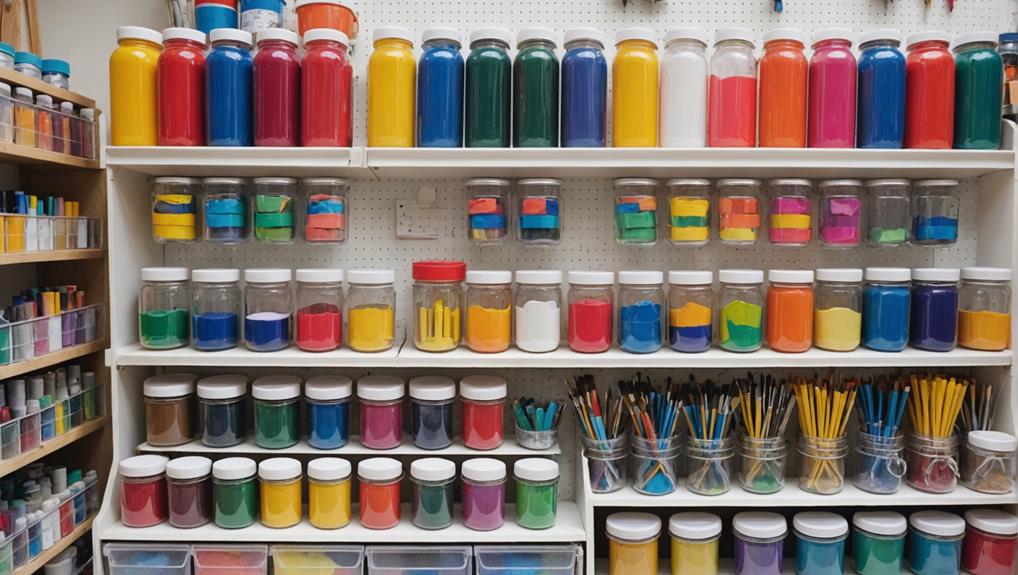
Effective paint storage solutions are essential for maintaining the quality and usability of your acrylic paints, ensuring consistency and vibrancy in your fluid art projects. Proper paint container organization and effective sealing methods not only save you time but also preserve the integrity of your materials.
To make sure your paints are in top condition, consider the following tips:
- Tupperware or sealed pots: These are perfect for storing leftover paint, keeping it fresh, and preventing it from drying out.
- Cling film: This can be used to cover paint containers, allowing you to store mixed colors for use the next day without losing consistency.
- Warm environment: Store your paints in a warm place to prevent freezing, which can ruin the paint’s texture and usability.
- Squeeze bottles: Pre-mix your colors and store them in squeeze bottles for easy access and controlled pouring during your projects.
Additional Supplies
In addition to paint storage solutions, fluid artists require various additional supplies to enhance their creative process and guarantee successful outcomes.
One essential item is kitchen roll, which serves a dual purpose. Not only does it help with cleanup, but it is also a fantastic tool for swiping techniques, allowing artists to manipulate paint in unique ways that can bring new dimensions to their work. Understanding color theory can make these techniques even more effective, inspiring artists to experiment with different hues and patterns.
Another useful supply is cling film, perfect for short-term storage of mixed paints. This simple material helps preserve colors overnight, making certain they remain fresh for the next day’s session.
For more detailed work, palette knives and brushes are indispensable. These tools enable artists to add texture and intricate details to their pieces, expanding their creative possibilities and sparking artistic inspiration.
It’s also a good idea to keep a list of essential supplies handy. This guarantees that artists are always prepared and never caught off guard during their pouring and painting sessions.
With these additional supplies, fluid artists can fully explore their creativity and produce stunning, vibrant works.
Frequently Asked Questions
What Do You Need for Fluid Art?
To excel in fluid art, essential items include silicone cups for color mixing, precise measuring jugs, reusable mixing sticks, a blowtorch for popping bubbles, protective equipment, and high-quality acrylic paints. These tools facilitate advanced pouring techniques and vibrant results.
What Equipment Do You Need to Be an Artist?
To be an artist, essential equipment includes a variety of high-quality artistic supplies like paints, brushes, and canvases. Additionally, a dedicated creative workspace with proper protective gear and leveling tools guarantees precision and cleanliness during the creative process.
What Does an Artist Always Need?
An artist always needs an artistic mindset and creative inspiration. These fundamental elements drive innovation and expression, enabling the creation of meaningful and impactful art, regardless of the medium or tools at their disposal.
What Are Some Tools of Liquid Drawing Media?
Some essential tools for working with liquid mediums include watercolor brushes, synthetic sable brushes, watercolor pencils, markers, droppers, squeeze bottles, silicone cups, and mixing sticks. These tools facilitate precision and control in various pouring techniques.
Conclusion
In summary, mastering fluid art requires an extensive understanding of various tools and materials.
From selecting the right acrylic paints and pouring mediums to preparing surfaces and ensuring proper paint storage, each element plays a critical role in achieving desired artistic outcomes.
This guide highlights the essential tools and supplies, providing a foundational framework for both novice and experienced fluid artists to enhance their creative processes and produce visually engaging works of art.

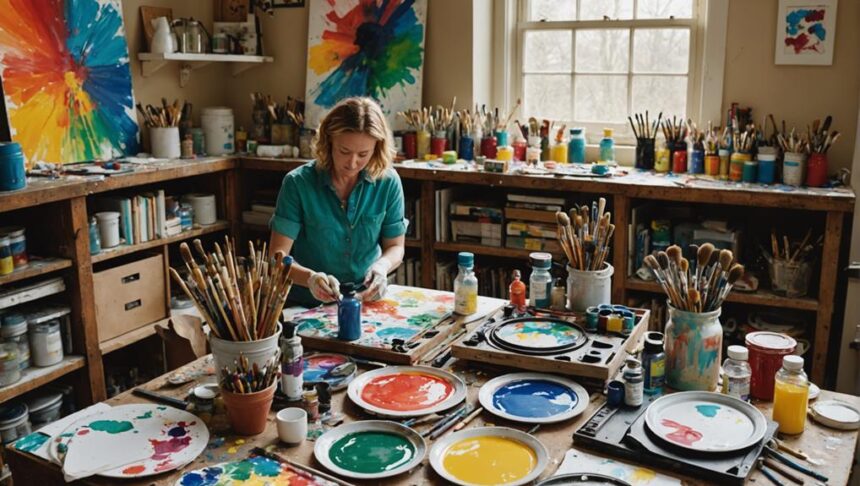
Leave a Reply